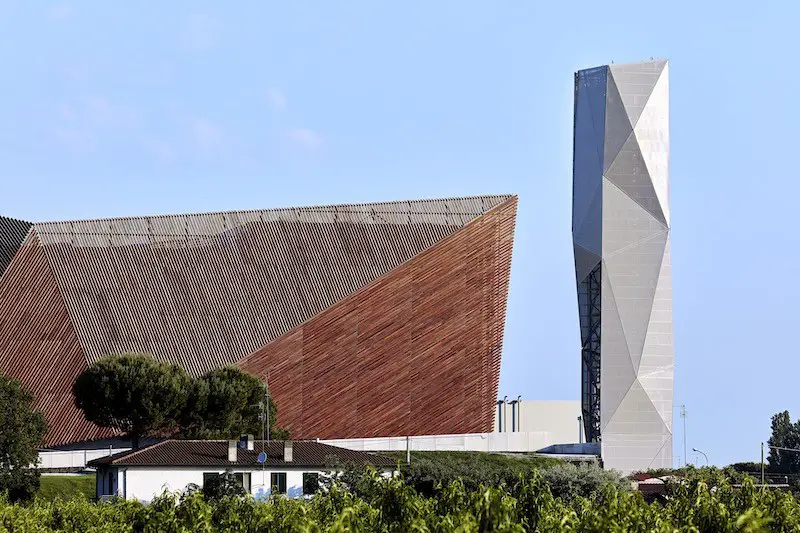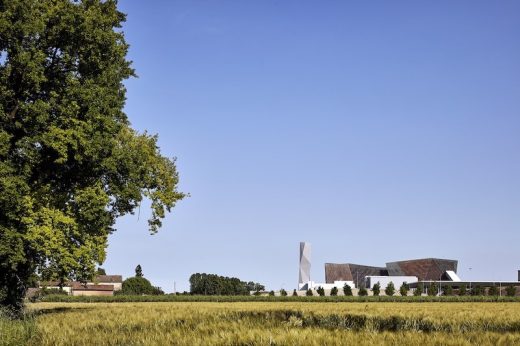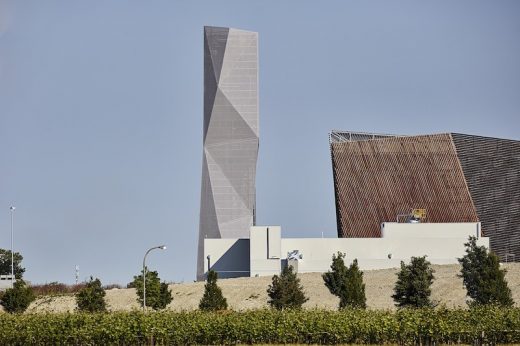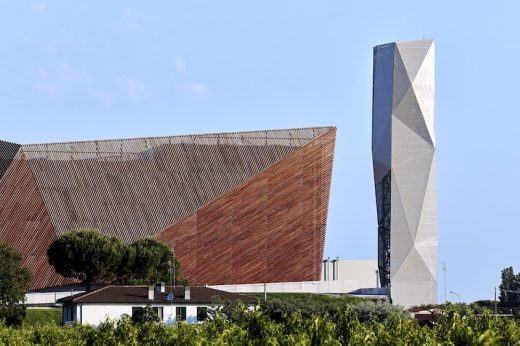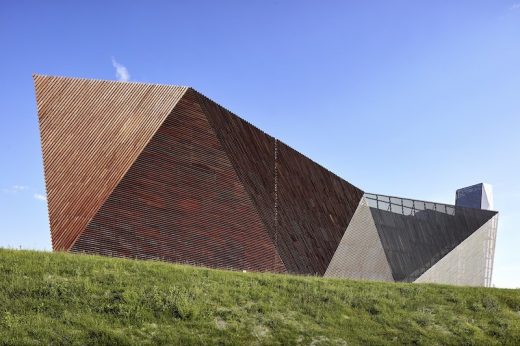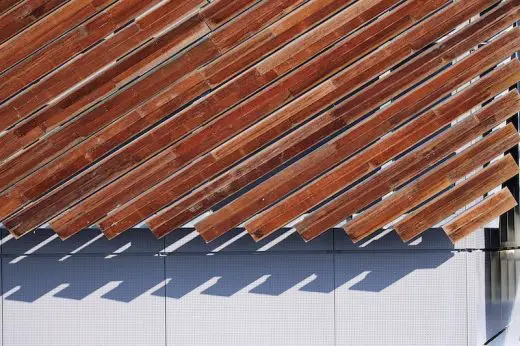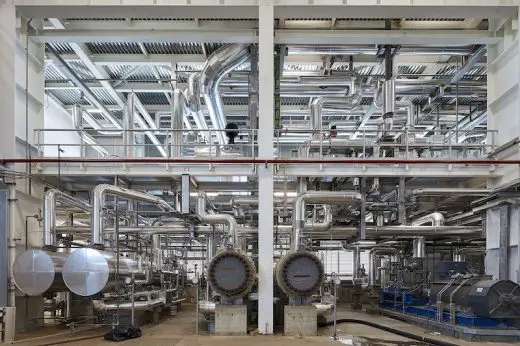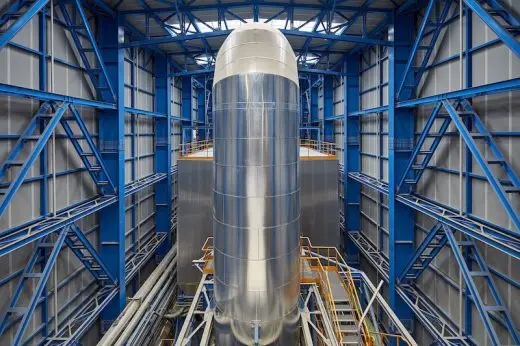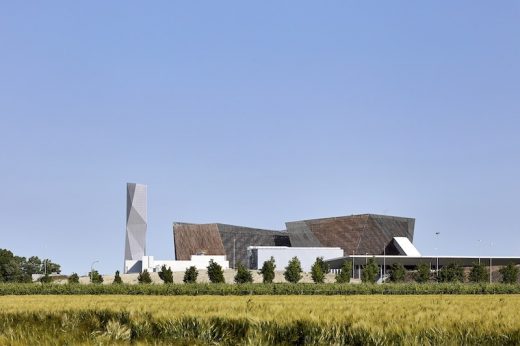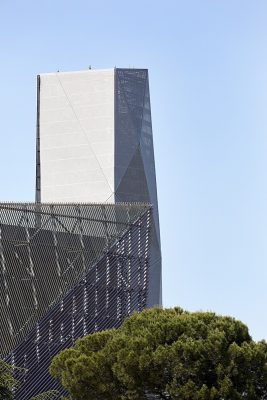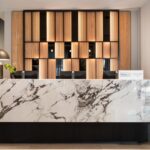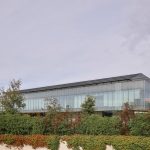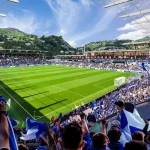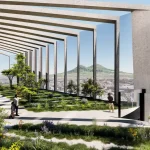Powerbarn Russi building, Ravenna architecture, Emilia-Romagna property, Italian architectural design news
Powerbarn Russi, Ravenna, Italy
post updated 26 March 2024
Design: Giovanni Vaccarini Architetti
Designed By Giovanni Vaccarini Architetti, Powerbarn Redefines The Relationship Between Energy Production And Agricultural Land
Photos by Massimo Crivellari
26 Feb 2020
Powerbarn in Russi – Ravenna Building
A virtuous example of coexistence between the industrial and the agricultural world, Powerbarn by Giovanni Vaccarini Architetti in Russi (Ravenna, Italy) interprets the conversion process of part of an industrial area, once property of the Eridania sugar company, into a bioenergy production plant.
Surrounded by dunes and natural pathways, the new pole for the production of electricity from renewable sources is fully encircled by the territory it derives its energy resources from. The architecture of the large furnace building, which dominates the area, offers mutable and faceted displays of itself. Its imposing mass is disguised by means of a wooden skin inspired by the Razzle Dazzle mimetic strategy of military origin.
A short film by The Piranesi Experience and photos by Massimo Crivellari reveal its qualities.
Bounded to the North-West by the final stretch of the Lamone river, crossed by the railway line that leads from Faenza to Ravenna, bordered to the South-East by the Carrarone road (onto which its very entrance opens), the former industrial area, that once hosted the Eridania sugar factory, lies on the edge of a wide agricultural land. The area, adjacent to the city of Russi, in the province of Ravenna (Italy), is still dedicated to the historical cultivation of sugar beet and fruit trees, encompasses 47 hectares.
This large district, linked to one of the leading agri-food industries in the Italian entrepreneurial history, has now discontinued the production of sugar on this very site, keeping here only the boxing and storage phases, hosted in an area of about 46,000 square meters. Approximately 280,000 square meters of the site, including three large wetlands, have been restored, re-naturalized and given back to the community; while a program of conversion of the former industrial areas is underway for a part of the remaining area, measuring more than 167,000 square meters.
An environmental vision that takes the shape of dunes situated along the edge of the site.
The new pole for the production of electricity from renewable sources is located in Russi, in the heart of the Italian region of Romagna. The project was designed by Giovanni Vaccarini Architetti, an architectural firm experienced in numerous environmental mitigation projects and well established both nationally and internationally. An environmental-oriented vision informs the master plan: in its integration with the agricultural and farming landscape, the buildings designed by Vaccarini surface from the ground as if they were crystals.
“Our intention was to create something similar to a natural bastion, almost a dune, along the edge of the area now converted into the pole for energy production – hence an element closely linked to the ecological functions of an environment. Not a barrier, but a functional element that would express our design intentions: to create a permeable, accessible and living element,” says architect Giovanni Vaccarini.
The masterplan for the pole defines a low-tech environmental system originating from the design of the earthwork, that serves as an interface between the rural and industrial spheres. “The entire project starts with the design of its edges”, says Giovanni Vaccarini, explaining how he was able to carry out a clever environmental mitigation for the project through the presence of the “dunes” (an element typical of the Adriatic landscape) built along the entire perimeter of the area.
With a height ranging between three and ten meters and surmounted by trees and pathways, accessible to both pedestrians and cyclists, the edge of this area was designed by Vaccarini as a natural embankment. Thus defined, the margins of the intervention create an interface between agriculture and energy production.
Energy is produced from the cultivated land all around.
The choice of Giovanni Vaccarini Architetti to surround the site with accessible dunes and naturalistic pathways, instead of using industrial fences, is strongly related to the desire to establish a relationship of openness between the pole and its surrounding territory. The biomass plant itself (with a power of 30 MWe) is fueled with wood chips in addition to residues from mowing and cleaning of river banks and pruning, all materials that come from within a 70 km radius of the site.
Consideration for the environment was at the forefront of the architects’ minds. In order to further minimize the impact of the pole on its territory, the dunes were built employing only the earth that resulted from the construction site excavation, then covered with fresh soil and planted with vegetation.
The annual production of the pole is estimated at 222 GWh, which will satisfy the needs of 84,000 families, guaranteeing significant savings in the emission of greenhouse gases into the atmosphere. In addition to the production of energy from wood chips, the pole also houses a biogas plant powered by livestock sewage and a small photovoltaic energy plant, of approximately 1,000 square meters, both contributing to the production of clean energy.
The guidelines from the European Union set the target on the use of renewable sources at 20% by 2020 and 32% by 2030. Currently, the energy produced from biomass contributes to 10% of all energy resources and represents the most important share of renewable energy, amounting to 59%. In 2016, the largest consumers in absolute terms of bio-electricity were Germany, France, Italy, Sweden, and the United Kingdom. Italy is also a major consumer of bio-heat, along with Germany, the UK, Sweden, and Finland.
Powerbarn generates a multifaceted architecture that reinterprets historical camouflage techniques.
The furnace building and the adjacent chimney are the most characterizing architectures of the intervention, both in terms of size and for their design. Positioned along the Carrarone road, their volumes appear to be imposing but yet mitigated both by the presence of the dunes, which minimize the perception of their height, and by a sophisticated camouflage on their outer surfaces, faceted into a sort of kaleidoscope of triangular shapes.
The main building (i.e. the furnace and smoke line) has a remarkable size: measuring about one hundred meters in length and over thirty meters high. The chimney, which is located next to the furnace, reaches a height of 50 meters. Behind these buildings are the engine rooms, the large condenser, the ample canopy under which wood chips are stored and dried before being led to the furnace through a conveyor belt.
Further beyond, following Vaccarini’s design of large rectangles that may recall the shape of urban blocks, are located vast areas where the wood chips are moved and stored. Composting areas and the biogas production plant are located on the opposite side of the site.
The masterplan also includes a building for offices, an electric substation and an area for the collection of waste water.
What really strikes the attention of the observer is the multifaceted pattern that Giovanni Vaccarini designed for the external skin of the two main buildings: large triangular surfaces envelope the volumes of the furnace and chimney, cleverly subverting their geometries. Made with steel structures, they are weaved with wooden panels, laid in a parallel pattern.
The weave of the wooden shingles does not follow a uniform pattern, but instead it changes direction on each face, thus offering to the observer an ever changing perception of the building, that varies depending on the point of view and the different hours of the day or light conditions. The wooden cladding is also a tribute to the art of weaving and nomadic architecture.
“The Razzle Dazzle camouflage technique is extremely interesting to me. I studied it very closely in order to then be able to conceive an unconventional architectural solution. This is not about hiding, but rather about proposing a different reality to the observer, a more complex and deceptive one that, paradoxically, tends to attract his attention, making him wonder at what he sees.”
Giovanni Vaccarini
In order to conceive this solution, Giovanni Vaccarini resorted to a Cubist-inspired technique of military camouflage developed during the Great War in the military marine industry. Known as Razzle Dazzle, this technique was originally used with the purpose of making the identification of British ships difficult, despite their significant size. It consists of a series of lines and graphic signs that interrupt and face each other, defining a disjointed motif which consequently confuses the observer’s perception, making it difficult to precisely estimate the distance and size of the object.
The architectural solution is consistent with the overall idea of environmental mitigation that inspired the project. Giovanni Vaccarini has already demonstrated his interest in the perceptive dimension of architectural elements on other occasions: in his design for the SPG Headquarters in Geneva, for example, he was inspired by kinetic art in order to transform the mass of the building into a seemingly abstract and immaterial body, through the use of glass fins positioned on its envelope.
With the project for the pole for the production of electricity from renewable sources in Russi (Ravenna, Italy), Giovanni Vaccarini Architetti’s portfolio is enriched by a new important experience that interprets an extremely challenging and crucial issue with competence and environmental sensitivity, outlining a new and remarkable example of architectural research in Italy. It is for this reason too that a short film has been dedicated to Powerbarn and the challenge promoted by its project. Produced by The Piranesi Experience, the film is directed by Daniela De Francesco.
The short film “SUPERFICIE TESSUTO CORPO”, directed by Daniela De Francesco and produced by The Piranesi Experience and Wisebits, with the collaboration of The Architecture Player, explores the architecture of Powerbarn, the bioenergy power plant designed by Giovanni Vaccarini Architetti in Russi (Ravenna, Italy). Part of a large conversion program of re-naturalization of the previous industrial site owned by Eridania sugar company, Powerbarn is a virtuous example of coexistence between the industrial and the agricultural world.
Surrounded by dunes and natural pathways, the new pole for the production of electricity from renewable sources is fully encircled by the territory it derives its energy resources from. Within this system, the furnace building and the adjacent chimney stand out for their architectural quallities.
The short film, that briefly resumes Giovanni Vaccarini’s design research by referencing some of his previous built projects, introduces the theme of the surface which, in his work, almost turns into a fabric and hence into a body. The project for Powerbarn in particular hints to the Razzle Dazzle mimetic strategy that takes cues from a military camouflage technique. The building offers mutable and faceted displays of itself that vary depending on the weather, time of day and season.
Giovanni Vaccarini himself guides the narratio in the short film, by recounting the significant steps in the design of Powerbarn, starting from the conceptual phase up to the definition of its relationship with the natural environment all around. Fabio Paolucci’s photography exalts the ethereal, almost abstract, qualities of the building. Daniela De Francesco of The Piranesi Experience leads the viewer to discover the solid but ever-changing materiality of the project by Giovanni Vaccarini for the bioenergy power plant in Russi (Ravenna, Italy).
Title: SUPERFICIE TESSUTO CORPO
Director: Daniela De Francesco
Director of photography: Fabio Paolucci
Soundtrack: Lucia Paradiso
Colorist: Paolo Verrucci
Editing assistant: Claudio Esposito
Running time: 10 minuti
Specs: 4K UHD – Italian / English subtitles
Production: The Piranesi Experience, Wisebits
Distribution: Image MEDIA AGENCY with The Architecture Player
Watch the short film “Superficie Tessuto Corpo”:
Superficie Tessuto Corpo from The Architecture Player on Vimeo.
Distribution In Partnership With www.piranesiexperience.it
Post: Giacomo Neri
Lab: Reel One
Sound: Paolo Ballarini
Supervisor: Marco Brizzi
Produced By: Claudio Esposito
Architecture By: Giovanni Vaccarini Architects
Photographer: Massimo Crivellari
Powerbarn Russi Building images / information from Giovanni Vaccarini Architetti
Location: Ravenna, Italy
New Italian Architecture
Contemporary Italian Architecture
Italian Architecture Designs – chronological list
Ravenna Harbour Apartment Building
Design: Zucchi & Partners (Cino Zucchi, Nicola Bianchi e Andrea Viganò)
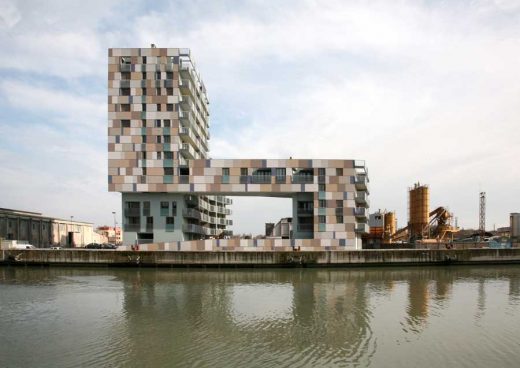
photo from Zucchi & Partners
Ravenna Harbour Apartment Building
Medolla’s Ecdysis Building
Design: Disguincio&co
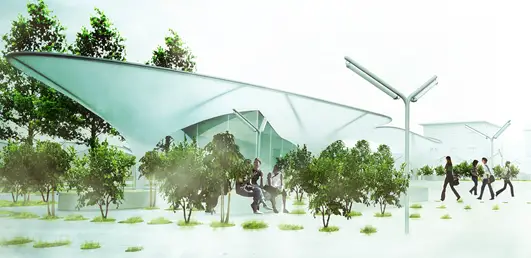
image by architects
Medolla’s Ecdysis Building
Winery in Chianti, central Tuscany, central Italy
Architects: IB Studio
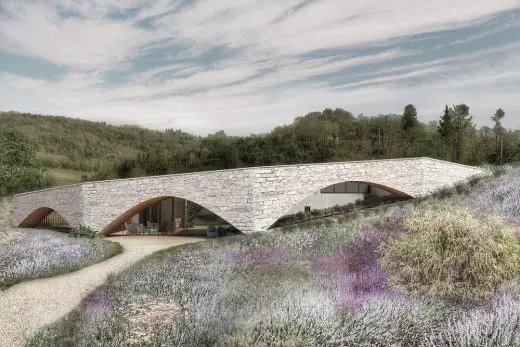
image Courtesy architecture office
Winery in Chianti
vc1 Residential Complex, Cesena
Architects: tissellistudioarchitetti
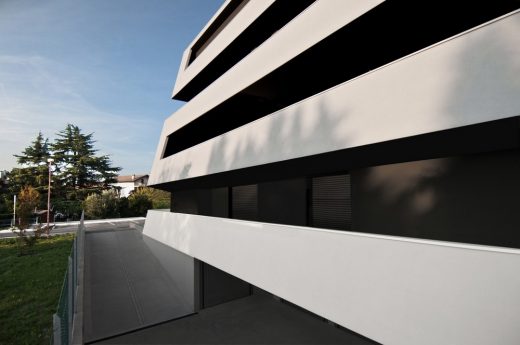
photo : tissellistudioarchitetti
Residential Building in Cesena
Buda House, Cesena
Architects: tissellistudioarchitetti
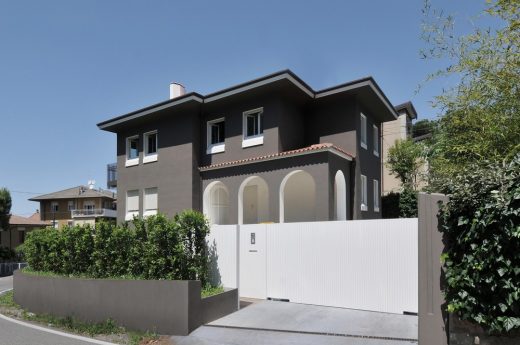
photograph : Filippo Tisselli
Buda House in Cesena
Technology Center Bologna
gmp · von Gerkan, Marg and Partners · Architects
Technology Center Bologna
Domus Technica, Brescello
Iotti + Pavarani Architetti
Domus Technica Italy
Bologna Civic Offices
Mario Cucinella Architects
Bologna Civic Offices
Cesena Apartments
tissellistudioarchitetti
Cesena Apartments
Cesena Housing
tissellistudioarchitetti
Cesena Housing
LightNing Tower, Maranello
Tstudio
LightNing Tower Maranello
Buildings / photos for the Powerbarn Russi, Ravenna, Italy by Giovanni Vaccarini Architetti – Architecture page welcome

